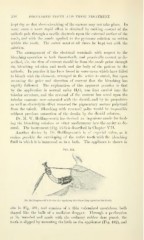Page 558 - My FlipBook
P. 558
55G DISCOLORED TEETH AND THEIR TREATMENT.
kept dry so that short-circuiting of the current may not take place. In
some cases a more rapid effect is obtained by making contact of the
cathode pole through a needle electrode upon the external surface of the
tooth, and with the anode applied to the pyrozone solution on cotton
within the tooth. The cotton must at all times be kept wet with the
solution.
The arrangement of the electrical terminals with respect to the
bleaching operation is both theoretically and practically correct as de-
scribed, viz. the flow of current should be from the anode point through
the bleaching solution and tooth and the body of the patient to the
cathode. In practice it has been found in some cases which have failed
to bleach with the elements arranged in the series as stated, that upon
reversing the poles and direction of current flow the bleaching has
rapidly followed. The explanation of this apparent paradox is that
by the application in normal order H2O2 M'^as first carried into the
tubular structure, and the reversal of the current has acted upon the
tubular contents now saturated with the dioxid, and by its propulsive
as well as electrolytic effect removed the pigmentary matter pulpward
from the tubuli. Bleaching with reversed poles would be impossible
without previous saturation of the dentin by the dioxid solution.
Dr. M. AV. Holliup-sworth has devised an ingenious anode for feed-
ing the bleaching solution or other medicament into the cavity as de-
sired. The instrument (Fig. 154) is described in Chapter VII.
Another device by Dr. Hollingsworth is of especial value, as it
makes possible the enveloping of the entire tooth with the bleaching
fluid in which it is immersed as in a bath. The appliance is shown in
Fig. 481.
Dr. Hollingsworth's device for applying the bleaching agent to the tooth.
situ in Fig. 481, and consists of a thin vulcanized caoutchouc bulb
shaped like the bulb of a medicine dropper. Through a perforation
at its rounded end made with the ordinary rubber dam punch, the
tooth is slipped by mounting the bulb on the applicator (Fig. 482), and


